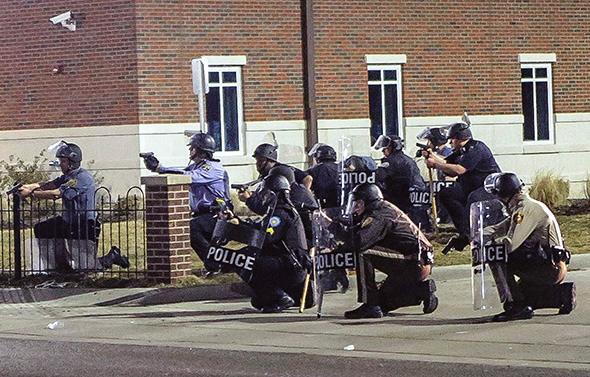On early Thursday morning, outside of the Ferguson, Missouri, police station, unknown assailants shot two police officers: one in the shoulder, one in the face. They were part of a group of officers standing side by side forming a blockade between protesters and the station. Both are in serious condition, but neither injury is life threatening. Thankfully, they will live.
But it’s not clear if we can say the same for the Ferguson protest movement, which was also harmed by the shooting. Just hours earlier, Ferguson police chief Thomas Jackson had resigned from his post. His departure followed on the heals of four others, all fallout from the Justice Department’s scathing report on the city’s kleptocratic police practices and racist language. Last week, it was two police officers (who resigned) and the city’s top court clerk (who was fired). And on Tuesday, it was City Manager John Shaw, who the Justice Department named as key to the entire scheme of spurious arrests and draconian fines.
Chief Jackson announced his resignation with a press conference at the police station, and when protesters gathered to meet him, it was a celebration as much as a demonstration. And for good reason: Despite major setbacks, activists—with a strong assist from the federal government—had begun to bring accountability to the city of Ferguson and had started the hard and painful process of institutional change.
Because the shooting happened during the protests—albeit hours after Jackson’s resignation, when they were waning—there’s a strong chance they’ll be associated with the protesters, even if the shooter wasn’t involved in the demonstrations or the movement writ large. Already, area police officials are calling it deliberate. “This is really an ambush,” said St. Louis County Police Chief Jon Belmar during a Thursday morning news conference, later clarifying to say that he didn’t “know who did the shooting. … But somehow they were embedded in that group of folks.”
And while he didn’t want to condemn the full range of people protesting—“That’s not an indictment on everybody that’s out there certainly expressing their First Amendment rights”—he also thought something like this was inevitable, given the anger of the protests and some of the participants. “When you look at the tenor of at least some of the people involved in the protest or civil unrest, it can be troubling,” he said. “I think it’s a miracle that we haven’t had any instances similar to this over the summer and fall.”
Police are investigating, but at present we have no idea who shot the officers, or why. And it’s that lack of information that makes this a dangerous moment for Ferguson reform. Fixing the city, or even just ameliorating its problems, requires good faith and buy-in from all stakeholders, from Ferguson police and city officials to community leaders and the persuadable white Ferguson residents who are neither involved in the movement nor actively opposed to it. Indeed, both Department of Justice reports were valuable because they laid neutral ground for action. Almost everyone could acknowledge that former Officer Darren Wilson was innocent of legal wrongdoing and most everyone could agree that the city was corrupt and unfair.
The shootings shatter this nascent detente. As Attorney General Eric Holder said in a Thursday morning press conference, “Such senseless acts of violence threaten the very reforms that nonviolent protesters in Ferguson and around the country have been working towards for the past several months.” As with the killings in New York City in December, there’s a chance these shootings could completely derail any attempt to repair the relationship between the police and the policed.
With that said, the reform effort is still viable. But it will take even more work than before to establish trust and build a common basis for change. For activists, part of that will be loudly repudiating the shooter, which they’ve already done. On Twitter, one of the early Ferguson organizers, Deray McKesson, expressed his sympathies for the officers while reiterating the concerns of the protesters. “My thoughts and prayers go out to all victims of violence,” he wrote, “The movement is bigger than any one moment. What was true yesterday is true today—we fight for justice because police brutality is real. What was true yesterday is true today—we have never advocated the shooting of police as a means of justice.”
If activists have to take a definitive stand against the shooter, then city officials have to understand this isn’t a reason to stop working with protesters. And on that count, there are some signs for optimism. “We want peace in our community,” said Ferguson Councilwoman Kim Tihen in an interview with the St. Louis Post-Dispatch. The former city police officer isn’t sure “what more” the protesters want, but she “would like to ask them to come to us” to “tell us what we can do to continue to heal the community.”
“We are willing to work with them, the protesters in general,” she said.
